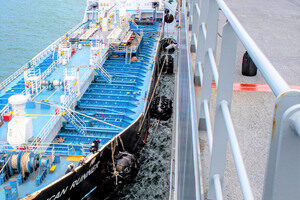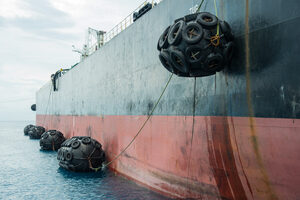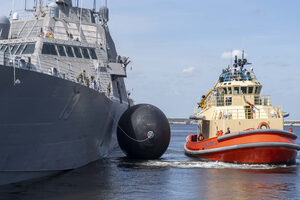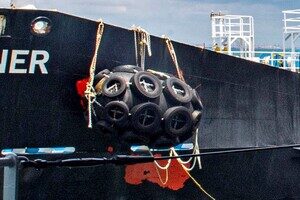Ocean Guard™ Pneumatic Fenders, also known as Yokohama type fenders or floating fenders, are an essential part of port operations, as they protect people, ships, and infrastructure from berthing operations. Pneumatic fenders are made of abrasion-resistant rubber and filled with compressed air to float on water. They are an effective solution for ports or harbors with high tidal variations, temporary berthing, and ship-to-ship applications.
Ocean Guard™ Pneumatic Fenders can withstand massive berthing forces and extreme weather conditions. They can also be deflated easily for simple, cost-effective relocation or on-deck storage.
Pneumatic rubber fenders have high energy absorption with a low reaction force and are relatively lightweight for their size. They come in several different types, such as:
- Chain-tire-net (CTN) fenders: These fenders are covered with a lattice of tires and chains for fender skin protection and extra standoff.
- Hydropneumatic submarine fenders: Hydropneumatic fenders feature low hull pressure, variable draft, and protect against acoustic tile damage. These fenders are specifically designed to help submarines dock safely. They are submerged deeper in the water for more effective fendering.
- Sling/hook type fenders: Sling fenders feature lifting/towing eyes on each end, with no CTN. They can be slung by ropes or chains.
Ocean Guard™ Pneumatic Fenders Features
The performance of every fender is of utmost importance, so they have to meet the standards set by ISO 17357:2014. Depending on whether or not it is a CTN fender, manufacturers can use molding and/or wrapping techniques to create the fender.
These fenders are available in two grades, standard low hull pressure 50 kPa, or higher-pressure models of 80 kPa. Pneumatic fenders consist of an outer rubber body, an airtight inner rubber body, a synthetic tire-cord layer. Sling-type fenders have integral end fittings, while the Chain and Tire models have their end fittings built as part of the chain and tire assembly.
Here are some other key features and benefits of pneumatic fenders:
- Easily deflation for relocation or storage
- High strength and friction resistance with inclined berthing
- Low transportation costs
- High energy absorption with a soft reaction force for ship and jetty structures
- Easy maintenance
- Adjustable performance via varying internal pressure
What Are Ocean Guard™ Pneumatic Fenders Used For?
All four main types of Ocean Guard™ Pneumatic Fenders share the same purpose: to protect berthing structures and vessels in ports and ship-to-ship operations. Pneumatic fenders are ideal for the following applications:
- Temporary berthing
- Ship to Ship transfers
- Rapid response or emergency rendering
- Containers, LNG carriers, tankers, bulk cargo ships
- Ocean and offshore platforms
- Terminals
- Tugboats and yachts
- Ferries and aluminum-hulled vessels
Choose Ocean Guard™ Pneumatic Fenders at Marine Fenders International, Inc.
Ocean Guard™ pneumatic fenders are manufactured to IAW ISO 17357 as well as other relevant industry standards to ensure that the fenders you request meet the quality you expect.
With over 30 years of experience producing marine fenders and buoys, Marine Fenders International is a leading fender manufacturer for the U.S. Navy and many other customers. We work closely with naval personnel, engineering companies, and contractors to develop solutions that protect crucial naval assets.
For specific information on the products we supply and the clients we serve, visit our Navy Industry page.
Contact us or request a quote to learn more about our products and capabilities.




